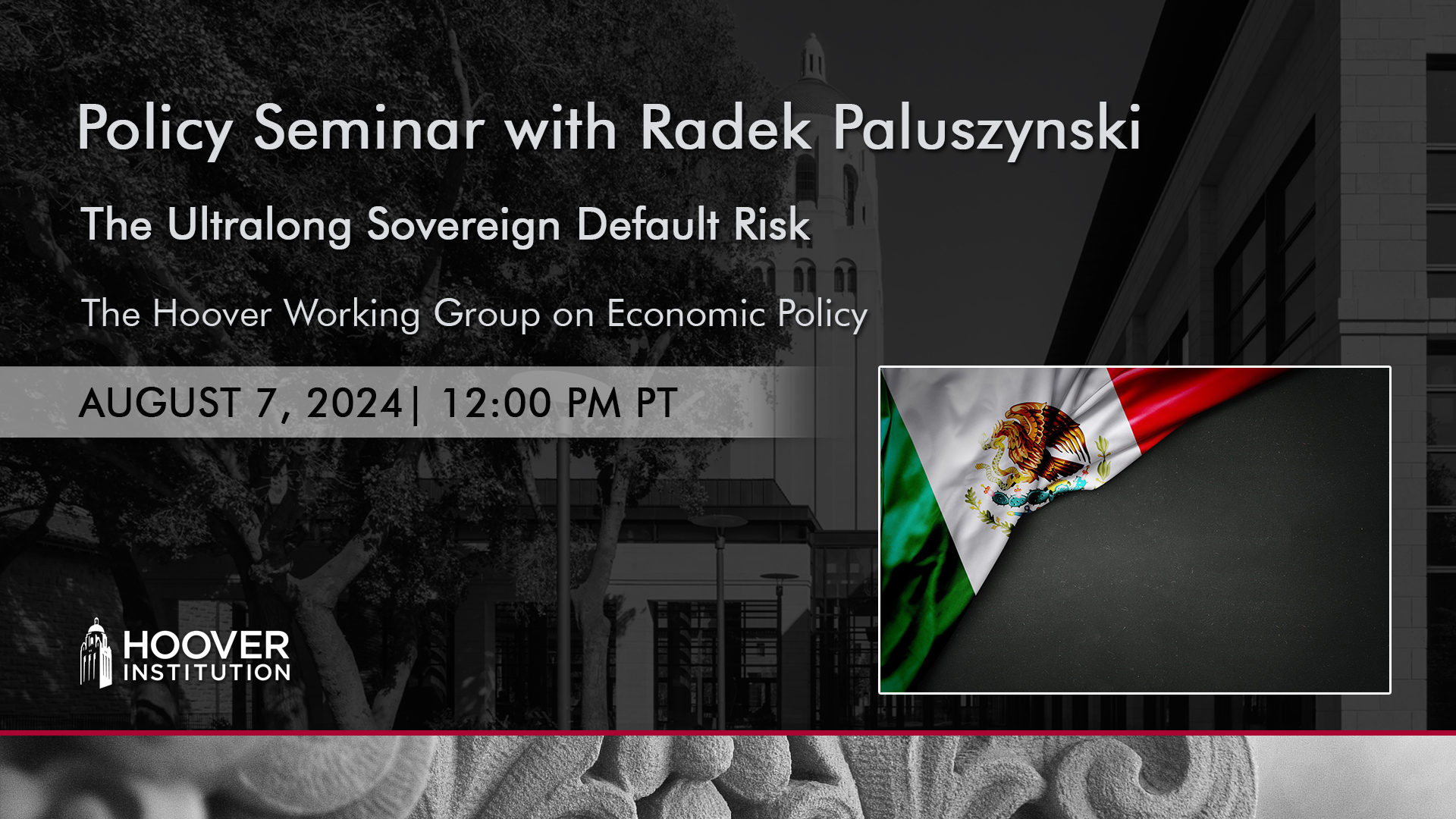PARTICIPANTS
Radek Paluszynski, John Taylor, Annelise Anderson, Doug Branch, Ruxandra Boul, Pedro Carvalho, John Cochrane, Andy Filardo, Daniel Flynn, Paul Gregory, Bob Hall, Ken Judd, Roman Kräussl, Evan Koenig, Hyunju Lee, Tom Stephenson, Jack Tatom
ISSUES DISCUSSED
Radek Paluszynski, associate professor of economics at the University of Houston, discussed his paper “The Ultralong Sovereign Default Risk.”
John Taylor, the Mary and Robert Raymond Professor of Economics at Stanford University and the George P. Shultz Senior Fellow in Economics at the Hoover Institution, was the moderator.
PAPER SUMMARY
Between 2010 and 2015, Mexican government issued external debt worth 0.5% of its GDP in the form of century bonds. Using a sovereign default model with endogenous maturity and variable risk-free rate, I propose a theory of the ultralong debt issuances and investigate the resulting bond spreads. Government issues such bonds in order to insure against low-frequency movements in the risk-free rate, and the benefit from such hedging is largest when interest rates are low. The model calibrated to Mexico’s default history comes remarkably close to predicting the spreads on 100-year bonds observed in the data. This suggests that Mexico is expected to remain a frequent defaulter in the next century.
To read the paper click here.
To read the slides, click here.
WATCH THE SEMINAR
Topic: “The Ultralong Sovereign Default Risk”
Start Time: August 7, 2024, 12:00 PM PT
John Taylor: Well, we're ready to begin. Have this great seminar I've been looking to for a year, you've been visiting for a few years. It's been terrific. Radek Paluszynski, I got your name right.
Radek Paluszynski: That's right, yeah.
John Taylor: And the title is the Ultralong Sovereign Default Risk. And you're gonna tell us everything you need to.
Radek Paluszynski: Thank you very much. So thank you very much for this opportunity to present to you, and thank you for coming. Thank you for connecting to the folks online. So, public debt issuance and management is obviously a huge part of government economic policy. And in addition to managing levels of debt, dynamics of debt, there's also a long tradition of thinking about sovereign debt maturity in economics, the maturity structure.
And there's a tremendous literature, both focusing on positive analyses of maturity structures of governments around the world, also normative prescriptions. What should government do in terms of its debt maturity? So this paper analyzes a recent emergence, or perhaps a reemergence, of old new instruments, which have been popularly called the ultralong bonds, and hence I kind of inherit this term.
Ultralong bonds, my working definition are gonna be bonds with longer maturity than the longest maturity bond that the US government issues, which is about 30 and a half years. So for many decades following World War II, that was the longest-maturity sovereign bond that you would see in financial markets.
And only over the last 25 years or so, we have observed an emergence of bonds with maturity much longer than that, ranging actually up to 100 years. I say it's an old new instrument because actually a century ago, it used to be norm for some of the advanced governments at the time to manage their public debts in the form of consoles, so basically bonds that do not have a specific maturity date.
And actually, the UK government repaid the last one of those bonds only in 2014. But in a way, the world has changed tremendously since then, and we've had many decades without such instruments, so I kind of treat it as an emergence of something new. And the phenomenon has been- These are flat nominal monsters, right?
That's right.
Speaker 3: So in real terms, which is natural, you're really talking about a wedge that goes down to typical rates of inflation, after 30 years of 2% inflation, there's not much left.
Radek Paluszynski: Absolutely, yes.
Speaker 3: Are you measuring the duration of the bond in real terms?
Radek Paluszynski: Yeah, so the duration obviously is much shorter than, for example, 100.
It's, you know, in my quantitative analysis of the model, I'll try to hit exactly kind of the average duration of these bonds, taking into account the real claims that they offer. But it's still much beyond what has been the norm, and especially what is the norm for the US.
Speaker 3: Queen Victoria issued consoles under the gold standard, so they were like index perpetuities. If we're gonna have 2% inflation target, we want nominal bonds, why don't they just coupons rise 2% a year?
Radek Paluszynski: Would that make abundant sense?
Speaker 3: Well, we have into extent small amounts of it, yes.
Radek Paluszynski: That's a good point. So this new instrument has still been somewhat niche, but far from trivial. There's a wide range of countries that have issued such bonds, from countries like Mexico, Argentina, Peru, to countries like Japan, UK, Switzerland. So basically, the question I approached, they asked myself and tried to answer is why issues at securities, and especially why recently, why right now?
And as with all hard problems in economics, there are many avenues and many factors that contribute to an emergence of something new. My focus here, which is coming from my original research interests, but also something that I think caught attention of financial market commentators the most, is the role of default risk.
And these countries issuing such bonds, which are typically considered frequent defaulters. So for example, here is a quote from the Economist commenting on Mexico issuing several batches of 100 year bonds, arguing that perhaps conjecturing that foreign creditors are very bullish. These are extraordinarily good terms, given Mexico's distinctly spotted credit records.
So the reception was that perhaps the sign that Mexico is now able to easily issue 100 year bonds is also a sign that investors have better faith in Mexico's credit records than in the past.
Speaker 4: So if you issue short-term debt, you got to roll it over.
Radek Paluszynski: That's right.
Speaker 4: So it's not obvious that from a bond investor point of view, you're better off with short-term debt rather than long-term debt. So they get in trouble, it's a rollover crisis, you're done. If you have a long bond, they get in a crisis, okay, they stop paying interest for a while, you hash it out, you agree, maybe get our interest back later.
The rollover crisis actually could make short-term debt more risky than you either get paid off or you take a huge haircut and it's nuts, there's no extent you pretend going to visit.
Radek Paluszynski: So pretty much, John just summarized most of the gist of the paper here. We can just call it the day, but absolutely.
So there's a hard trade-off involved there and I'm gonna try to highlight it and kind of quantify the solution to this trade-off. I'm just kind of providing the feel of the markets at the time. I think most commentators were genuinely puzzled that-
Speaker 5: Regarding Mexico, didn't we bail them out?
Radek Paluszynski: In 95, that's right?
Speaker 5: Yeah, so now who we bailed out by the American banks bought some of these but-
Radek Paluszynski: That's right.
Speaker 5: Yeah, we bailed them out. Now perhaps the market is thinking that that could happen again.
Radek Paluszynski: Absolutely, but even beyond that bailout, in the 100 years prior to 2015, Mexico had 3 external defaults, so that would have been a near fourth.
Speaker 4: It's gonna go the other way. So I know the Greek bailout in detail. The Greek bailout since they sat know the ECB came in, all the short-term guys who were rolling over, they got out and it was actually long-term bondholders this time eventually took the haircuts.
Speaker 5: I don't know what the details are, I just know we bailed them out and I think we even made money up.
Speaker 4: That's right.
Speaker 5: I don't think the Germans made money on the Greek bailout.
Radek Paluszynski: But I mean, that's the most recent episode when Mexico dodged the bullets. So that may also have been part of the calculus. So, a summary of this paper is that I'm gonna show you some evidence on the issuance of these ultra long bonds over time and interest rates.
And then because this is such a new phenomenon and very limited data, there isn't much to do with formal empirical analysis. So I'm gonna resort to building a model with endogenous maturity, endogenous sovereign default, and crucially, variable risk free interest rate. And so some results that I'll try to convince you of emerging from this model is that these ultra long bonds are useful to hedge against low frequency movements in the risk free interest rate.
So it's precisely the insurance story. And the benefit of this insurance is largest when the interest rate is persistent, very persistent as it is in the data, and low. I'll have this model calibrated to Mexico's default history. So basically, a country that defaults three times per century and show you that they roughly capture the recent ultra long issuances and the corresponding spreads.
Not bad and kind of big part of the story is that this default risk precisely helps to motivate the hedging when the rates are low. So it's not really that the default risk is an inhibitor to issuing such debt for the government. But actually the presence of default risk makes the government even more motivated to buy some more insurance.
So before I jump in, maybe I can just summarize or try to convey intuition for the main mechanism of hedging versus incentive in my model. So this is gonna be a trade off between the hedging benefit of long term debt and incentive benefits of short term debts. So if you think about an impatient borrower, like most governments who accumulate large debts, we think of them as impatient.
The long term debt in general insulates such borrowers from shocks to risk free interest rates. So if you have an impatient borrower observes that the interest rate is very low today and expects it to go up in the future, then this increase in the risk free interest rate will be the bad news.
It will make the impatient borrower suffer. But at the same time, a rise in this interest rate will reduces bond prices and reduces the present value of outstanding debt obligations. So in that sense, it insulates borrower from shocks to this risk free rate. And precisely when the risk free rate is very persistent, the benefit of the hedging from something like an ultra long debt is the largest.
So that's the upside, but there's obviously a downside of issuing such an instrument because it has these negatives, incentives to default properties. So precisely the fact that the borrower is insured against these shocks in the future makes them less willing to keep the debt in check and attain better rollover conditions, better bond prices.
So that ends up increasing the future default risk comes from the lack of commitment of the government. And the investors know it today that in the future their bonds will be diluted and.
Speaker 3: Why, you issue long term debt versus short term debt? Why do you have more incentive to default, getting long term care?
Radek Paluszynski: Because tomorrow you will wake up and you precisely don't have to worry about shocks and keeping your overall indebtedness in checks because you basically, you're insured. The rollover of the debt is less painful and as a result, if you're impatient, you can actually increase your overall borrowing.
So that's the debt dilution channel. So that comes from lack of commitment of the government. Today the government issues long term debt and would like to promise investors that in the future it will keep fiscal discipline and keep prices of this debt high.
Speaker 4: Is this about risk?
Radek Paluszynski: It's about doubt.
Speaker 4: Or is it about just default? Is default I promise to pay back. They're rolling over short term debt. It doesn't matter. I mean, if we're on the same interest rate path, whether I default to my long term debt or short term debt, it's the same default.
And let's see why there's a difference. You said something about if there's an interest rate shock, it's not obvious to me why after an interest rate shock. In fact, I would think the other way. Interest rates go up and I have short term debt. My God, now I gotta pay more on this short term debt.
That's the fall.
Radek Paluszynski: That's right. So you will reduce your overall indebtedness to still roll over the debt at high prices, right? You don't wanna roll over the debt at interest rates of ten or 15%. But especially if all of your debt was in the form of perpetuities, then you can just sleep tight.
You don't have to worry about keeping your fiscal policy in check for the investors. And as a result, investors are diluted.
Speaker 5: There's a bunch of diamond and Raijan stuff about how the.
Radek Paluszynski: Same logic, but for sovereign.
Speaker 5: Threat versus people to be okay.
Radek Paluszynski: Yeah, so at the end of the day, there is a solution to this trade off between the positive hedging feature of long term debt and negative incentives feature of long term debt.
And I'll show you the solution to this. What I'm not gonna talk about, but are also important forces, is the demand structure and potential clientele effects. So this is not your everyday market. The buyers of these ultra long bonds have been concentrated among pension funds, life insurance companies, who have preference for specific maturities.
And that is also a big driver of these decisions, for the governments to offer bonds at these specific maturities.
Speaker 4: There's a point, I think it was early two thousands when the UK said pension funds, you gotta buy long term government bonds and long term government bond yields just go boom.
Radek Paluszynski: That's right, because
Speaker 4: Regulation.
Radek Paluszynski: regulation. So often these types of institutions face regulatory duration mismatch. So basically they have liabilities spanning decades into the future and the regulation requires them to kind of match it up with some cash flows from assets. So they have demand for these types of.
Speaker 6: Do you think that you had a trade off due to forces? Did something change to make one of those more salient than the other one? Why the change in the demand issue?
Radek Paluszynski: So in a way, the change, which I'll highlight but I think works also to for this force is this trend in the risk free interest rate around the world.
The decline in the risk free interest rate around the world also makes the regulation more kind of binding for these types of investors.
Speaker 4: The external forces, the decline in the risk free rate.
Radek Paluszynski: That's right.
Speaker 4: And that's gonna change this trade off of incentives.
Radek Paluszynski: Precisely.
Speaker 4: But you're not looking at the decline in the term preview.
Radek Paluszynski: No. I mean.
Speaker 4: The other sort of obvious one is governments look at like european governments 10 year bonds, negative yields, yeah. Here, yeah am good.
Radek Paluszynski: Yeah, actually I have a backup slide on this maybe I can show it to you in just a moment.
I'm also going to restrict my attention to countries that are small and do not control or do not make decisions about the currency in which these bonds are issued. So I'm not going to focus on incentives to default by inflation or some kind of sovereign market power. I'm also not going to talk about the role of debt maturity in providing commitment to the timing of taxes, it's a separate literature that goes back to Lucas and Stokey.
Okay, so let me start with showing you some evidence. So this is new issuance of ultra long bonds. Again, ultra long bonds are any bonds with maturity higher than 30 and a half years, which is the longest maturity bond that the us government ever issued. So this is just a simple sum of real amounts and so you can see how there is some blips in late 80s, also late 90s and then really this market kind of gets started in, starting from 2000 and then these issuances come in some kind of waves.
So the central kind of relationship that I'm looking in this paper at is the relationship between these new issuances of the ultra long debt and this real interest rate, the risk free interest rate, which is just assumed to be the US one. So we've had a declining trend of this real risk free interest rate since the beginning of the eighties.
And so at some point it seems like when it fell to a level low enough, the whole market kind of got started. So that would be kind of a change in the extensive margin and then also if you look at specifically the period post 2000, also these waves of issuances are correlated with these kind of local cycles of the real risk free interest rate.
So not surprisingly, the correlation between the two is actually very negative. So precisely when this real rate dips, that's when we observe a whole new wave.
Speaker 3: Now this is all common sense, however, the US didn't participate in this kind of shift.
Radek Paluszynski: That's right, it did not.
Speaker 3: Then we do shortening at times.
Radek Paluszynski: That's right, yeah.
Speaker 3: Is there any explanation for why that was the case?
Radek Paluszynski: So, I certainly know that there were discussions at the treasury about potentially issuing a 50 year bond it didn't go anywhere. I talked to Darrell Duffy about it, and he's a fan of the or proponent of the clientele effects story.
And simply he argues that there are no specific demands for these kind of bonds for the US but obviously for US, it's a much deeper issue than for countries like Mexico.
Speaker 3: Wall Street was against.
Speaker 4: right?
Speaker 3: Yeah,
Radek Paluszynski: when Mexico or Austria say issues a bond like this, probably you can assume that nothing in aggregate changes for the market.
If the US issues a brand new bond in high amounts that has the power to influence the whole market. So.
Speaker 3: Well, us share of debt in the world is large I mean, it's like 10, 15 percent. I think if you do the Hereford index, it wouldn't be that big on the level that we would this evoke antitrust policy if this was so.
Radek Paluszynski: So I'm not gonna look at the countries that our own currency issuers. But some of the ones that did issue, like UK, Switzerland, Japan, they were still, they were kind of cautious about this, right. So none of them went to maturities beyond 50 years and still they kept their amount.
Speaker 3: What did Austria issue there?
Radek Paluszynski: Austria issued 100 year in addition to a 70 year bond.
Speaker 3: In what currency?
Radek Paluszynski: In Europe,
Speaker 3: In euro
Radek Paluszynski: but I'm assuming that Austria is small enough that it's not really.
Speaker 3: What about Mexico?
Radek Paluszynski: Mexico issued in a range of currencies, euro dollar, british pound.
So this is just to give you a sense of pricing, so this is a snapshot of euro denominated yield curves for Mexico and for Austria, which I take here is some kind of a risk free benchmark. So you can see, so I think this is a snapshot in 2019, shortly after Austria issued its own 100 year bond.
So you can see that both the yield curves are increasing and also the spread curve, which is the difference between them, is increasing. And so we have the spread at the hundredth year of about two and a half percentage points. If we plot it over time, it's actually pretty stable between two and a half and three percentage points.
Obviously, in periods of stress like in Covid or when the US interest rates start rising, it goes up but then it falls back down. So this is as a comparison, this is the Mexico to US 10 year spread. So overall, the pricing of these bonds is fairly stable and there's some endogenous spread term premium.
That is also gonna feature. Okay, so unless there are some other questions, I'm going to describe my model to try to think about this phenomenon. So it will be a model of small open economy government with endogenous default. It kind of follows the steps of a large literature that has developed over the past 15 years or so, going back to Ariana Chatterjee Eigenvor, with some additional new elements which I highlight here in bold fonts.
So, I'll have a stochastic process for income but also for a risk free interest rate which is typically assumed to be a parameter. I'm assuming that government acts on behalf of households to smooth out and front load consumption, so debt is useful to smooth out shocks, the effects of shocks to consumption, but also the government is impatient, so it accumulates large amount of debt.
Two types of defaultable debt, one with shorter, one with longer maturity, and in the case of default, there are two punishments, direct cost to income, which is typically needed to generate large amount of debt in equilibrium, and temporary exclusion from credit markets. I'm going to assume zero recovery rate for debt following a settlement on default, and I'm also going to assume that international lenders are perfectly competitive risk neutrals.
These two assumptions I have an extension where I relax both of them. Them in a way they complicate a lot and they offset each other out to some extent. So in this version, I don't have them.
Speaker 6: Now, there's obviously more than two types of debt. Because if somebody uses a 30 year bond, then tomorrow it becomes next year, becomes a 29 year bond, next year, 28 year bond-
Radek Paluszynski: Absolutely, so let me talk about this, so this is an issue in modeling debt maturity In that if we were to take it literally. Then we would have an enormous state space, simply because we would have to keep track of the amount of debt outstanding at every possible maturity.
So that would be not a tractable problem.
Speaker 6: A paper of mine with Felix Kubel and Carl Schmeder did.
Radek Paluszynski: Okay, I'll take a look at this after talk.
Speaker 6: Well, I call the track.
Speaker 4: You get a bigger computer. Yeah.
Speaker 6: Actually, PC in the fairly.
Speaker 4: I was just joking.
We can handle 30 dimensional state spaces if you want to be.
Radek Paluszynski: To make this somewhat of, let's say, more tractable for everyday users. The typical modeling approach, is to assume that bonds are perpetuities with declining coupon payments over time. So you issue an amount of bond and it has some decay parameter delta.
And so, for example, here's just an illustration, if this delta is equal to one, then it's a one period debt. Tomorrow you have to repay it, and the outstanding amount is zero forever. On the other hand, it's an actual perpetuity, then delta is equal to zero and the maturity date never comes.
You just keep rolling it over until you may buy it back one day. Then for some delta in between, like here, for example, 0.33. This is the profile of outstanding amounts over time. So we typically choose this delta, to kind of approximate the average debt maturity across different terms.
So in the literature so far, there have been some papers that modeled endogenous debt maturity by having two, by choosing amounts of two bonds. And these would be one short term, one, one period debt. So like the black line over here, and one generic long term debt that will approximate for the whole stock of long term debt.
That will be like this red line in my paper here, I'm gonna have also two. But I'm going to treat this something like this red line as my shorter term debt. And I'm gonna have something that looks like this blue, but not exactly because I wanna fit a the duration, as mentioned at the beginning, but something close to this blue line.
So that's gonna be the market structure, so we have stochastic processes. For it's an endowment economy, so log income is just the sum of realized growth rates of income. And this crucial new thing is that, one process for the risk free interest rates rather than it being a parameter.
Speaker 3: So the interest rate, the growth rate.
Radek Paluszynski: No, I don't assume any relation, but obviously I could, there is a relationship.
Speaker 4: R equals delta plus gamma g, is the state
Speaker 6: first order condition tends to link this.
Speaker 4: I guess you're thinking about the income growth of a small country.
Radek Paluszynski: Small country, that's right.
Speaker 4: And the interest rate is being international, so that would be. Yeah,
Radek Paluszynski: so the aggregate states are the outstanding amount of this generic long term debt b, the outstanding amount of ultra long debt, b u. And the vector of the stochastic states, which is the previous period income level, which actually after detrending it, drops out.
And then gross rate of income and level of the risk free interest rate. In every period, the government chooses whether to repay or default by comparing the values associated with these two actions. In the case of repayment, it chooses the level of consumption and the new amounts of the two bonds.
Where the budget constraint is such that, consumption is equal to income minus the repayment of the two types of debt. I'm assuming here that the coupon on this regular maturity debt is equal to one. So the coupon is basically the government just repays the full b, whereas the coupon on the ultra long debt is some number kappa.
So the government repays the a maturing fraction of delta u. And on the unmatured portion of that bond, it pays the coupon and then it issues new debt net of what's outstanding, what rolls over into the next period. And it gets these endogenous prices Q and QU. In the case of default, there is some linear loss of a fraction of income.
And then, the government is excluded for a stochastic number of periods, where each period it has a probability theta of re entering. And if it's readmitted to the markets, it kind of starts over with zero debt starts accumulating. If it's not readmitted that it continues in default.
Speaker 3: So the consumers here, the people, they have no assets, they just basically eat whatever.
Radek Paluszynski: That's right, it's like the only decision make, basically the government makes decision on behalf of households.
Speaker 3: Independent savings or assets.
Radek Paluszynski: Yeah, I mean, because we are thinking here about external debt, right? So it's like the government manages this external debt. There could be also domestic debt.
Speaker 5: Don't some Mexicans own some of this debt that's issued by the government?
Radek Paluszynski: They issued the domestic debts, so for the ultra long bonds for Mexico, it's pretty much all of it is owned by foreign residents. So that's why it's kind of, it simplifies, it's also all in foreign currency.
Speaker 4: So, it is your function of debt here, is to smooth consumption and exports and imports are your only way of.
Radek Paluszynski: That's right.
Speaker 4: The government manages that as opposed to the vision of government that say the barrel or, a Judd vision of government debt, where what you're doing is you have tax receipts.
Well, you wanna smooth the tax rate and you have temporary spending needs. I don't know if it would make a difference, but they're two very different objectives.
Radek Paluszynski: So in a way, here we abstract from taxing domestic citizens and issuing debt to them.
Speaker 5: Now, your autarky punishment, that means that there's no.
Not only autarky in finance markets, but also no, it's also autarky in the goods markets also.
Radek Paluszynski: Absolutely, so I mean- It is
Speaker 5: what happens when they get, when they default.
Radek Paluszynski: It is kind of a skeleton in this literature in the sense that Yes, we observed that sovereign defaults are associated with steep contractions in real economy, so that's the fact.
Speaker 5: Yeah.
Speaker 3: But obviously the causality of this is.
Speaker 5: Yeah, but is it because-
Radek Paluszynski: Whether it's the contraction happens because government defaulted or whether the current defaulted because it's in the middle of
Speaker 5: Of actual fact. Does international trade die?
Radek Paluszynski: Yes.
Speaker 5: It's forbidden or it just dies because of economic, other economic reasons.
Radek Paluszynski: It's not forbidden, but the government has no access to financing of such trade. So, I mean, private citizens can potentially still trade with abroad. But for example, Argentina was essentially excluded from financial markets for 20 years.
Speaker 5: Yeah, financial markets, goods markets.
Radek Paluszynski: I mean, we observed that it's also kind of collapses.
Speaker 4: Finance imports, you got to export some capital and nobody wants capital. You can't finance imports. Certainly Greece, East Asia.
Speaker 5: The thing is that some Mexicans have dollar assets in American banks. I presume some Argentinians also had dollar assets in American banks or Swiss banks. So the assumption here is that the only holder of assets is the government.
Speaker 4: But to finance a trade deficit, you got to get people to hold more of your assets and nobody wants them.
Radek Paluszynski: Yeah, I mean, I agree with you, it's not a perfect assumption. I mean, there's definitely some trade that keeps going simply because private residents can do it if they have the funds.
But I mean, we do observe that it's pretty much collapses following periods like this, following events like this.
Speaker 5: I felt that the cocaine trade collapses.
Radek Paluszynski: Or maybe just, yeah, it changes form. Okay, so the other part of, or kind of to close the model is we got to specify these bond prices which are endogenous.
So the price of a regular maturity bond is a discounted expected cash flow from the repayment in the event that the government repays. So one minus this policy function to whether to default or not. And in the case of default, there is a repayment of coupon here which is normalized to one.
And then investors continue to hold one minus delta fraction of this debt that has the new value of q. That depends on the equilibrium policy functions of the government next period. So these b double primes are equilibrium objects. And so similarly for ultra long, and this is precisely where debt, where these problems with incentives come from.
Today, the government would like to sell long term debt and would like to promise that come next period, these b double primes will actually be not too high, will be kept in check. Such that, so that the investors can enjoy high bond price. But there's lack of commitment, and when the government wakes up next period, it will have incentive to increase debt if it has the capacity to do so.
And the investors foresee this debt dilution problem and already reduce the bond prices today. So that's the issue. So here's some more specific intuition, why issue long term debt at all? So here's like a stylized Euler equation for the choice of debt level with a generic decay rate delta I.
In reality, this problem is non differentiable. So it's not solved by actually calculating this Euler equation. But for the sake of illustration, we can write it down. So the left hand side shows the marginal benefit of issuing an extra unit of debt. Well, the marginal benefit is that you can increase consumption and you enjoy some marginal consumption.
How much will you get in terms of revenue? Well, you will get the price of that bond. But also you have to take into account that an extra unit of debt reduces bond prices across the board. Both of that bond, but also of the other bond. And in that way you reduce the revenue that you get from the issuance of all other outstanding units of not only this particular bond, but also the other bond.
So in a way there's like a Lafayette curve for the revenue from debt issuance. And an equilibrium where the trade off is resolved. That is equal to the marginal cost of issuing this unit of debt, which is the repayment of it tomorrow. So that's the repayment of coupon and tomorrow's value of that debt.
The price times the marginal utility of consumption tomorrow. And so here as an illustration, we can use the properties of covariance to actually rewrite this expectation of the product of two random variables. As the sum of the product expectations and the covariance between the, these two.
Speaker 3: Where did default tomorrow disappear here?
If borrowed more today, that might induce me to default more tomorrow.
Radek Paluszynski: That's right, so that's kind of, we're assuming that at this marginal unit here there's no default decision. But it does feature in the shape of these bond price functions.
Speaker 3: Yeah, I can see that as you get more likely to fall, those are going to get.
Radek Paluszynski: But precisely because this default is a discrete decision and generates a kink in the value function, we wouldn't be able to general right down this other equation. So this is more for illustration.
Speaker 4: Okay, so this is Max on the right hand side, yeah,
Radek Paluszynski: right. So basically, if to the extent that this covariance between marginal utility of consumption tomorrow and the bond price tomorrow is a negative term and large and absolute value.
The government is able to in a way reduce the marginal cost of issuing debt. And so in general, this covariance is negative, but precisely for debt with longer maturity, simply the volatility in these bond prices tomorrow is much higher. And this covariance term is potentially larger in absolute terms.
But obviously longer term maturity also has a more severe debt dilution problem. And so these partial derivatives are also more negative. So in a way the revenue from issuance declines faster. And so there is some solution to this trade off. And it's already been kind of shown in previous literature for hedging shocks to income, let's say.
My point here is that when you have a source of risk like the risk free interest rate, especially that feature these low frequency movements, then you really need the ultra long Debt to hedge against them, but also ultralong debt reduces incentives to repay faster. So to quantify the model, I estimate the parameters of these stochastic processes for the growth rate and for the risk free interest rate I conduct.
Speaker 6: Where do you get data for that? Where's the data for that GoPro?
Radek Paluszynski: So this is my quantification specifically for Mexico.
Speaker 6: Okay.
Radek Paluszynski: So these growth rates are just, it's just growth rates for Mexico's GDP since 1980 and for the risk free equation. So Cleveland Fed actually provides estimates of the risk free interest rate for the US starting from 1982 that incorporates data on inflation expectations and risk premium.
To have kind of longer series in order to be able to capture this level of unconditional mean of the risk free interest rate. That actually ended with data from 1955 where I calculate risk free interest rate as just interest rate, net of the currently observed inflation rate. That kind of assumes that inflation is a random walk or people have expectations.
Speaker 4: So we have this trend in the interest rate in the data.
Radek Paluszynski: There is, but actually, so this trend is part of my AR(1) process, right, so I have.
Speaker 4: We got some shocks that look like trend,
Radek Paluszynski: right? Exactly, so the unconditional mean is just above 2%, in early 1980s, the realization was six, seven, eight, and people were expecting it to mean revert.
More recently, the realization was even negative one and people were expecting it to mean revert upwards, so that's kind of important part of the story.
Speaker 5: Did you test the hypothesis that there was a trend, you're assuming here that there is R bar is like the long run target.
Radek Paluszynski: Right.
Speaker 5: Whereas beta indicates that there's kind of a downhill slope to it. Now that.
Radek Paluszynski: So that's why if I only used data from 1982, then yeah.
Speaker 5: Yeah, but in terms of the US long run risk free interest rate certainly go back, well, there's 55.
Radek Paluszynski: That's right, so if you start from 55, it kind of looks like friend that is stationary, so I did test for stationarity.
Speaker 5: I remember, I don't know a year ago or so, we had a seminar some of you had study of longer.
Radek Paluszynski: That's right, I've seen that since like 14th century.
Speaker 5: Yeah, and that there seems to be a long run trend there.
Speaker 4: I would also add, we're trying to understand the behavior people, and a lot of people in a lot of treasuries thought this was a trend that was going to go down forever. So it's easy enough for you to say, okay, well, what happens if we throw it a downward trend and that's what people's expectations are solid model, that way it's gonna go.
Radek Paluszynski: But there are also discussions among economists arguing that it actually will revert upwards finally, but demographic change, automation.
Speaker 4: All of the Blanchard and submerged companies that this was down for. Anyway,
Radek Paluszynski: if I were to assume it's down forever, then this story would not work.
Speaker 5: Really, okay, well, that's.
Radek Paluszynski: So the remaining parameters I calibrate using some external data and internal calibration to hit basic two moments, the average death holding and probability of default, which is three defaults per century, Kind of like what, how Mexico would behave.
Speaker 4: You didn't say a word about how you solve this model, which looks kind of hard to me, not to Canada.
So you got a value function for the individual that includes the equilibrium bond price.
Radek Paluszynski: That's right.
Speaker 4: You got a bond price function that depends on how the individual.
Radek Paluszynski: That's right, it's in general a hard problem, so I iterate jointly on the continuation value of the government and both bond prices and I update.
Speaker 4: So you're solving a fixed point inside a value function iteration.
Radek Paluszynski: So that's one way to solve it, I actually solve kind of jointly for a joint fixed point of the continuation value and bond prices, so it's like a one loop iteration. There are different ways to do this, I actually have one solution where I approximate, or I evaluate off grid points using cubic splines, which basically a very precise interpolation is needed to get this exact.
The more recent approach, which I also adopted more recently, is to assume there is a tiny shock in the decision of the government. So basically a trembling hand of some sort, following the IO literature going back to McFadden. Where you basically assume that the government has a distribution of potential choices which are very concentrated around some level of debt, but there is a possibility for noise in their decision.
Once you assume that, and assume that these noise shocks are distributed according to extreme value distribution, then you can get nice close form solutions for this and that facilitates.
Speaker 5: You can get close from solutions for the problem in the discrete choice
Radek Paluszynski: with. Respect to this discrete choice, that's right.
Speaker 5: Yeah and that closed form solutions for your whole problem?
Radek Paluszynski: No, absolutely not you still have to do value function iteration, but that just allows for this joint problem of the government's value and these bond prices to converge much easier.
Speaker 4: Smoothing out the default.
Radek Paluszynski: Smooth out the default. Yes, the default is discrete, but you add a little bit of noise.
Speaker 6: Now, your more fundamental problem is that when you have the max operator, there value today is a max or a couple things, you have non concavities popping in. So even the smoothing out the kinks, we still have a non concave value function, and that creates problems.
Radek Paluszynski: Yeah, so there are some non monotonicity, objects that should be monotonic.
Speaker 6: No, I mean, they should be, they aren't monotonic.
Radek Paluszynski: Yeah, in theory, in practice, yeah, they are not monotonic.
Speaker 4: But the theorem says that the iteration converges that.
Speaker 5: Yeah, you need shape preservation, all sorts of things for the theory to apply.
Radek Paluszynski: So here are some more illustrations, just for intuition here equilibrium bond prices. So this is what bond price you get for an amount of regular maturity debt that you choose and ultralong maturity debt that you choose. So these bond prices have a fairly standard shape in the sense that they are declining with more debt that you take on.
Initially they're declining mildly and then at some point there's some cliff, and beyond that cliff, the probability of default skyrockets and these bond prices plunge. So because the government is impatient, it typically oscillates somewhere around this cliff, a little bit away. And once in a while, a big enough shock pushes them off the cliff, and that's when these three defaults per century.
Occur, and so you can notice that for the ultra long bonds, their level overall is lower, and they are kind of more steep for lower levels of debt and less steep for higher. That's simply because the ultra long bonds take into account a much longer path of events and future.
So even if today's immediate default probability is high, they incorporate the periods of mean reversion when it's gonna be lower, and vice versa. Now, crucially for my story here is that obviously these bond prices vary with the risk-free interest rate, which is a shock in my model. And for some regular long-term debt, it varies somewhat, but much less than for ultralong bonds, right?
Ultralong bonds take into account a much longer path of these risk-free interest rates. And when the risk-free interest rate changes basically, the ultra long bond price changes by a lot more than the regular maturity. And so this extra volatility in ultralong bonds is precisely why it's a good hedge against risk-free interest rates.
So, regular maturity bond theoretically also hedges a little bit of against these kind of shocks, but quantitatively, much less than ultralong. And one period that would not hedge against risk-free interest rates shocks at all. So that's kind of intuition for the hedging itself. And then the question is, so why recently, when these interest rates were low, why do we observe such a rush to hedge, basically, to issue such debt, especially among defaulting countries?
So this is basically a, think about millions of simulations of default and non-default decision binary. And this is plotted against the growth structure realization on the y-axis and change in interest rate on the x-axis. So, quite intuitively, if the growth shock that you get is high, you don't default, these are the yellow dots.
If it's low, you tend to default, right? So there's some endogenous default thresholds in between, which is kind of fuzzy in this picture, because these are just simulations. And crucially, this endogenous default threshold varies with what's going on currently with the risk-free interest rate. So if the risk-free interest rate just goes down, then you may still repay even if you're in the middle of a 5% recession.
If it actually goes up, then you may default, even if the recession is only 2.5%. So this is kind of why when interest rate is kind at the bottom of the cycle and you expect it to mean revert, right. You're looking into the future that looks more like the right-hand side of this picture than the left-hand side of this picture.
And your demand for hedging is higher, to ensure against these potential events. So when I do the, just the simulation of the ergodic distribution, I find the overall share of these ultra long bonds of about 6%. Which is kind of in the middle of the range of what these countries issued, somewhere between one and ten.
For Mexico, it's about 5%. And the spreads on both types of bonds are about 3%, which reflects here the default probability those are targeted moment, simply because the investors are risk neutral. Now crucially, when I look at correlation, these shares, both the share of overall outstanding ultralong debt and the share of newly issued ultralong debt correlates negatively with this risk-free interest rate.
So that's why lower risk-free interest rate is when we expect in this model to see more issuance of these ultralong bonds. Here are some more statistics to kind of dig deeper into determinants of the hedging. If you remember, I mentioned to you that this correlation or covariance between marginal utility of consumption and the bond price is kind of crucial for the hedging.
And so here it shows that this correlation for the ultralong bonds is precisely more negative when risk-free interest rate is below unconditional mean than when it's above. And so as a result, we get larger outstanding amounts of ultra long bonds and new issuance of ultra long bonds when it's below the mean than above the mean.
Now obviously here, even when the hedging motive is there always, right, even if interest rate is at the peak of the cycle. So, my model really doesn't explain why we didn't see issuance of such bonds, let's say in early 1980s, because the prediction would be that the government would still issue some over there.
But critically, there is this negative correlation. I consider some alternative calibrations of this model. And so, most prominently-
Speaker 3: The other thing that's happened is the quantity of government debt has gone up tremendous.
Speaker 4: That's right.
Speaker 3: Which a straight consumption smoothly, I'm not sure that would get
Radek Paluszynski: right. This model-
Speaker 4: Why didn't they take long-term debt in the 90s? Because the debt to GDP ratio is 25%, and half of that was cash, so why bother, right?
Radek Paluszynski: Right, that's a good point. So in this model, I won't have it, right, there is ergodic distribution where the government picks this debt to GDP level and kind of oscillates around this. Now, there are some-
Speaker 4: I mean a time of low interest rates would be a time to issue a lot of debt and consumption.
Radek Paluszynski: That's right.
Speaker 4: So you might, I mean-
Radek Paluszynski: The government is impatient, yes.
Speaker 4: One of the things that senses intuitively is that interest rates got really low, government said, great, you know, let's borrow and go buy Mercedes.
Radek Paluszynski: That's right, so overall-
Speaker 4: You may have that hack.
Radek Paluszynski: Yeah, so overall, that went up. But within this increasing debt issuance fraction of the very long-term debt, first of all, emerged for these ultralong bonds and then went up.
Speaker 4: It's a natural question to ask of your model, do you capture the rise in government debt along with the declining interest rate, as well as the change in maturity sturgeon?
Radek Paluszynski: Right, to some extent I do, simply because when interest rate is very high in my model, this debt to GDP will be much lower than the unconditional mean. Now, I won't be able to capture the magnitude of the increase that we observed in the world. I think that's a question-
Speaker 4: Depends on your elasticity of interrupt substitution.
Radek Paluszynski: That's right, it's one-half over here. So it's not gonna allow for the kind of magnitude of the increase in debt that we've observed. Although I have a previous paper where I kind of get that, by having a regime switching in the parameters of the government.
So if we admit that there is some regime switch that occurred somewhere along the way, perhaps with Higher impatience playing the role, then that could be explained.
Speaker 4: Explaining a trend with regime switching is kind of cheating.
Radek Paluszynski: Yeah, in general, we don't really have great theories for why governments carry around so much debt, I would say at least quantitatively. So,
Speaker 4: if markets are willing to lend to you at -2% go borrow like crazy.
Radek Paluszynski: Right, so, I consider some alternative calibrations, so one of them is an economy that has higher debts. I just picked 50% higher debt to GDP and also 50% lower default probability. So, that would be proxying for example, the small European countries that also issue issued ultra long bonds like Austria, Belgium, Ireland.
And so interestingly, I also find them to have this hedging motive and to issue some fraction of their debt in the form of ultra long bonds. But this correlation is still negative but much weaker. So, really this seems like this default risk is important to drive this negative correlation.
I also consider variants of the model where either risk-free interest rate is a parameter, a constant, or just i.i.d. And I observed just negligible amounts of this ultra long bonds in equilibrium. So, it's really about high persistence in r that is needed to generate realistic levels. Okay, so in the last few minutes, maybe I just have two exercises to kind of answer.
So what, right, what are the implications from having this new instrument? So, here I just compare my baseline economy with ultra long bonds to an economy with the same parameters where I just shut down the access to this instrument, you can only use your generic long-term debt. And so, what I observe is the frequency of defaults goes up a little bit and there's a result debt to GDP goes down.
The volatility of consumption relative to income, the volatility of trade balance goes mildly up, overall, there is a small consumption loss. And in terms of consumption equivalent units, there's a utility loss of about 0.4% of consumption, so it's not a big number, but it's also not negligible. And yeah, having access to an extra insurance allows you to avert some defaults that you wouldn't have avoided without it, it affords you a bit less volatility thanks to the insurance property.
And so finally, we can actually see what the model predicts for Mexico, literally, right? So, I can pick the path of Mexican growth rates, growth shocks and the path of interest rate shocks and see the predictions for the model for these paths. And so, here I start in 1999, and so, in my model, the government issues the biggest chunk of the ultra-long bonds sooner than in reality.
So, already in 2001, I think, but then crucially, there are these two more waves in early 2010s and then right after Covid, where real interest rate drops to the lowest, actually negative values, and we still have these waves of issuance. So, if I were to plot the data, you would see these exact two spikes, they would just be higher.
So, simple explanation for this is that perhaps there's some transaction costs to organize the issuance of such a new security and it took some time before.
Speaker 3: Both Covid and 2008, the growth in the interest rate did have something to do with each other, Mexico and the US had catastrophically low growth.
Radek Paluszynski: That's right.
Speaker 3: The interest rate went down road.
Radek Paluszynski: That's right, so it's not on this picture, but these growth rates are fed in exactly.
Speaker 3: Okay, so even though it's not in the stochastic process, you do feed in.
Radek Paluszynski: I feed in the exact-
Speaker 3: Coincidentally.
Radek Paluszynski: Yeah, so in a way, these drops in their risk-free interest rate also allowed the government to avoid default in this case, with something like here's during COVID, it's a 9% decline in income. And this model would have certainly defaulted if it wasn't for this drop in the, The interest rate.
Anyway, so I get these two spikes, although in the lower magnitude. I also kind of get the pattern of the spreads, although also the magnitudes here are off. So, the ultra-long bonds command some spread term premium over regular maturity bonds. It's about one percentage point in the data, for me, it's much less.
But crucially, in the times of stress, it actually reverts, also for example, here's COVID. And the picture I showed you at the beginning also had this near reversal of the spread term premium in 2020. And then the bottom two panels just show you that with ultra long debt available, the government is able to have higher debt to GDP and consumption is less.
You can kind of see this lower volatility, the blue one is without access to ultra long bonds and it's kind of the standard deviation of this consumption is higher than width. So, it points to simply the hedging property of this instrument.
Radek Paluszynski: So, in my model, this is just a calibration to Mexico.
I have this one additional calibration for some generic, what I would call a small European country but actually I didn't do the path. So, that would be interesting, but yeah, the model is, I think Mexico is kind of the most interesting and also robust case of an ultra long debt issuer among emerging countries.
So, that was my original focus here. So, ultra long sovereign debt is an old but new instrument in financial markets. I'm proposing here a model of a government choosing to issue such bonds. And the key to this decision is the motive to hedge against low frequency movements in interest rates.
The model can rationalize these recent issuances and actually default risk rather than preventing Mexican government from selling hundred year bonds is actually something that motivates it due to this elevated hedging motive, precisely when rates are low.
Speaker 6: What about the US?
Radek Paluszynski: Yeah, I would view, I think other than my paper, there is one PhD thesis about this recent emergence of ultra long bonds just from empirical point of view.
So, in a way I think my paper is starting point to this but for the US,
Speaker 4: Your Mexico borrowing in dollars, so the option that you inflate away your debt,
Radek Paluszynski: It's not there.
Speaker 4: Isn't there,
Radek Paluszynski: Exactly.
Speaker 4: We have to think about that.
Radek Paluszynski: So, I am thinking about it, and I view it as my research agenda going on.
Speaker 4: And you also have to think about tax movement, not just international.
Radek Paluszynski: Absolutely, so you have to think about borrowing from domestic residents, you have to think about defaults to inflation more likely than outright defaults on bonds. You also have to think about market power of the US.
Speaker 6: So, US could borrow foreign currency?
Radek Paluszynski: It could, but it just doesn't, and I think it makes sense for it to, although the UK actually beyond debt denominated in pounds, it also borrows a little bit in US dollars and euros.
Speaker 5: What were Brady bonds?
Radek Paluszynski: Yeah, they were in dollars.
Speaker 5: Okay.
Radek Paluszynski: Other than that, I'm very grateful for your comments, thanks a lot for coming, and thank you for this whole amazing year over here.
Occupants of room: Thank you.



















